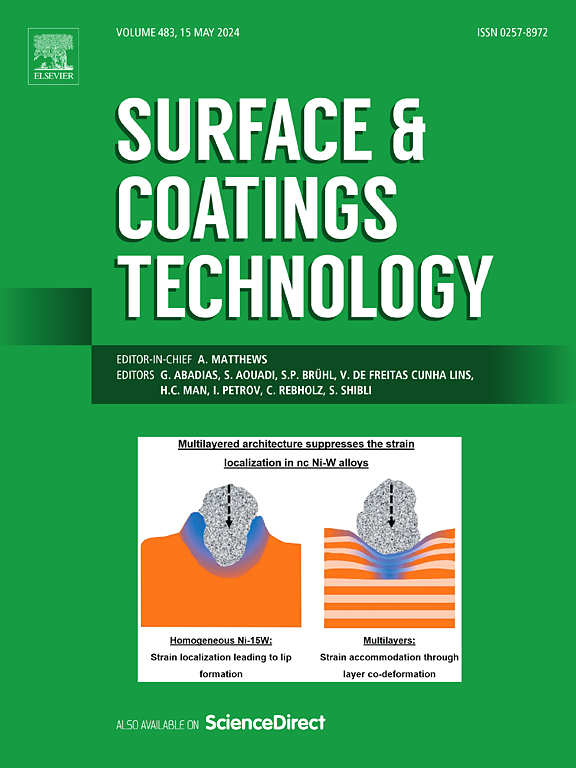Yb2Si2O7-CaF2-PHB高温可磨损密封涂层的孔隙率优化,以增强抗热震性
IF 5.3
2区 材料科学
Q1 MATERIALS SCIENCE, COATINGS & FILMS
引用次数: 0
摘要
目前,在陶瓷基复合材料(cmc)上设计和沉积匹配良好的可磨损密封涂层(ASCs)是提高发动机效率和性能的一大难题。ASCs的高孔隙率特性对残余应力和抗热震性能的影响尚未明确。因此,本研究考察了大气等离子喷涂Yb2Si2O7-20 vol% CaF2-(0/10/15/20 vol%) PHB/Si ASCs体系的残余应力和抗热震性。结果表明,孔隙率越高,顶涂层最大径向拉应力越大。此外,在孔隙附近观察到交变拉压应力。因此,实验结果中TC孔周围的微裂纹向孔的位置偏转,从而阻止了裂纹的快速扩展。此外,孔隙的引入阻止了TC处较大径向拉应力集中区的形成,同时减少了穿透裂纹,增强了抗热震性。然而,孔隙率越高,TC与Si粘结层(BC)界面处的应力波动越大。其中,径向拉应力受影响最大,导致界面裂纹增多。因此,适当的孔隙率约为35 vol%有利于提高热冲击性能。所建立的孔隙模型可为优化Yb2Si2O7-CaF2-PHB ASCs的cmc相容性提供基础。本文章由计算机程序翻译,如有差异,请以英文原文为准。

Porosity optimization in Yb2Si2O7-CaF2-PHB high-temperature abradable sealing coatings for enhanced thermal shock resistance
The design and deposition of well-matched abradable sealing coatings (ASCs) on ceramic matrix composites (CMCs) are currently a difficult challenge to improve engine efficiency and performance. The influence of the high porosity characteristics of ASCs on residual stress and thermal shock resistance has not been clarified. Therefore, this study investigated residual stress and thermal shock resistance in atmospheric plasma-sprayed Yb2Si2O7-20 vol% CaF2-(0/10/15/20 vol%) PHB/Si ASCs system. The simulation results indicated that higher porosity led to larger maximum radial tensile stress at the top-coat layer (TC). Moreover, alternating tensile and compressive stresses were observed near the pores. Thus, microcracks around the pores of the TC in experimental results deflected towards the location of pores, which stopped rapid propagation of cracks. Besides, the introduction of pore prevented the formation of large radial tensile stress concentration regions at the TC, while reducing penetrating cracks and contributing to enhanced thermal shock resistance. However, higher porosity gradually increased the stress fluctuations at the interface between the TC and the Si bond-coat layer (BC). Among these, radial tensile stress was particularly affected, promoting more interfacial cracks. Therefore, an appropriate porosity of about 35 vol% was beneficial for improving thermal shock performance. The pore model proposed could provide a foundation for optimizing Yb2Si2O7-CaF2-PHB ASCs for CMCs compatibility.
求助全文
通过发布文献求助,成功后即可免费获取论文全文。
去求助
来源期刊

Surface & Coatings Technology
工程技术-材料科学:膜
CiteScore
10.00
自引率
11.10%
发文量
921
审稿时长
19 days
期刊介绍:
Surface and Coatings Technology is an international archival journal publishing scientific papers on significant developments in surface and interface engineering to modify and improve the surface properties of materials for protection in demanding contact conditions or aggressive environments, or for enhanced functional performance. Contributions range from original scientific articles concerned with fundamental and applied aspects of research or direct applications of metallic, inorganic, organic and composite coatings, to invited reviews of current technology in specific areas. Papers submitted to this journal are expected to be in line with the following aspects in processes, and properties/performance:
A. Processes: Physical and chemical vapour deposition techniques, thermal and plasma spraying, surface modification by directed energy techniques such as ion, electron and laser beams, thermo-chemical treatment, wet chemical and electrochemical processes such as plating, sol-gel coating, anodization, plasma electrolytic oxidation, etc., but excluding painting.
B. Properties/performance: friction performance, wear resistance (e.g., abrasion, erosion, fretting, etc), corrosion and oxidation resistance, thermal protection, diffusion resistance, hydrophilicity/hydrophobicity, and properties relevant to smart materials behaviour and enhanced multifunctional performance for environmental, energy and medical applications, but excluding device aspects.
 求助内容:
求助内容: 应助结果提醒方式:
应助结果提醒方式:


